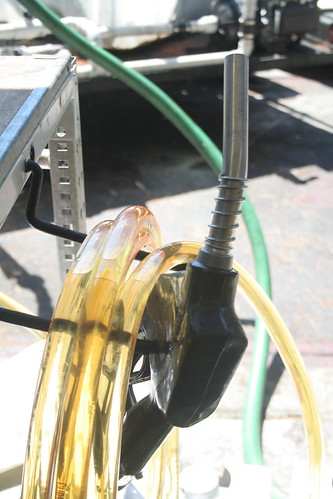Hello-
The research committee has completed .5 Liter tests on different washing methods. After the transesterification process, soaps and other contaminants are left in the biodiesel which can cause harm to diesel engines in the long run. Traditionally biodiesel is washed with water, but the water becomes a waste product since it has lots of soap diluted in it.
Commercial biodiesel producers use several different purification methods for the biodiesel, so we decided to try a couple of them including heating and Magnesol.
Heating removes the excess methanol from the biodiesel and since the soaps are dissolved in the methanol, when no methanol is left, the soaps congeal and can be filtered out easily.
Magnesol is a commercial solvent often used in cooking oil to extend its life. It is essentially synthetic magnesium silicate (talc powder), but it is finer and more absorbent than talc. The manufacturer reccomends using 2% by weight, but we wanted to investigate this claim since the manufacturers and sellers are somewhat biased.
To determine the cleanliness of the biodiesel, we performed a water wash test and examined the resulting water color. The more hazy the water, the more soaps that were still dissolved in the "washed" biodiesel.
We performed two sets of test, one where we heated the biodiesel and filtered out the soaps and one where we left the biodiesel unheated. Within these 2 sets we tested different concentrations of Magnesol (2%, 1%, .1%, 0%).
We found that the Magnesol was mostly effective at cleaning the unheated biodiesel at a concentration of 1%. The heated biodiesel required less than .1%, so it seems that heating the biodiesel and then using magnesol is the most economical option.
 This picture shows the heated biodiesel tests we performed. We heated the completed biodiesel until all the methanol was boiled off, and then filtered the soapy residue out of of the batch. The jar on the far left shows the heated batch without any magnesol. The jar in the middle had .1% magnesol (by weight). The jar on the right had 1% magnesol. The magnesol is added to the biodiesel and then filtered out with a 5 micron filter. The clearer the water, the cleaner the biodiesel.
This picture shows the heated biodiesel tests we performed. We heated the completed biodiesel until all the methanol was boiled off, and then filtered the soapy residue out of of the batch. The jar on the far left shows the heated batch without any magnesol. The jar in the middle had .1% magnesol (by weight). The jar on the right had 1% magnesol. The magnesol is added to the biodiesel and then filtered out with a 5 micron filter. The clearer the water, the cleaner the biodiesel. 
